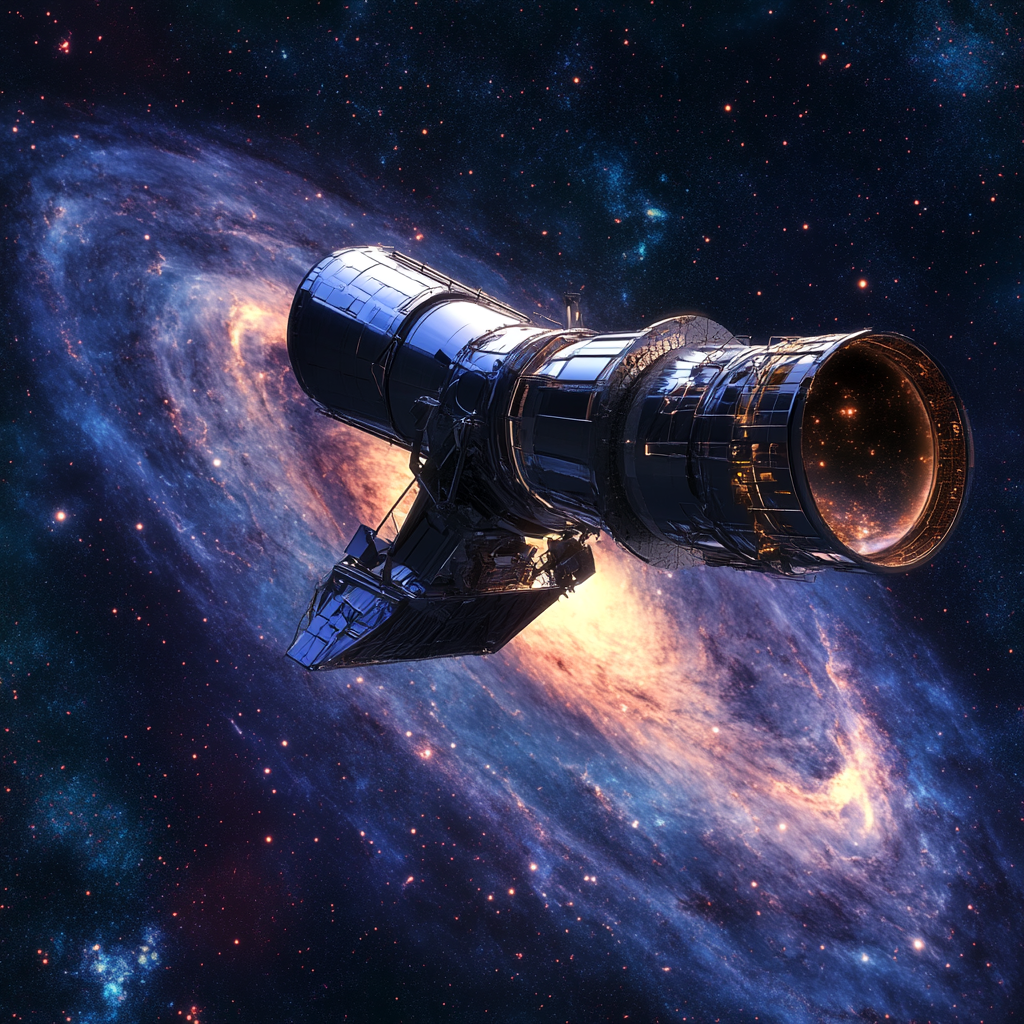
“NASA Equips Nancy Grace Roman Space Telescope with Advanced Optics”
In the grand tapestry of the cosmos, where stars twinkle like diamonds scattered across a velvet backdrop, NASA is preparing to unveil a groundbreaking piece of technology—the Nancy Grace Roman Space Telescope. Now, if you think a telescope is just a glorified pair of binoculars, get ready to have your mind expanded. This marvel, which was once affectionately known as the Wide-Field Infrared Survey Telescope (WFIRST), is set to take off into the great beyond come May 2027, and when it does, it will have a celestial detective's kit to rival anything you could ever imagine. Buckle up; we're diving into the universe's ultimate eye.
Now, let’s get straight to the point. At the center of this spatial spectacle is the Optical Telescope Assembly. It’s like the brain of the operation—recently delivered to NASA's Goddard Space Flight Center in Greenbelt, Maryland. Built by L3Harris Technologies in a facility that I'm convinced might rival Hogwarts, this assembly features a 2.4-meter (that’s roughly 7.9 feet for the less metric-inclined) primary mirror. And mind you, this isn’t just any ordinary mirror; it’s wobbling with precision and accompanied by nine carefully arranged secondary mirrors. They are essential for seizing and honing in on those elusive infrared signals floating out there in the cosmos. Think of it as the ultimate selfie camera for the universe—but instead of your average filter, it’s equipped with an infrared superpower.
Now, let’s roll up our sleeves and get to the juicy nuts and bolts. First off, the primary mirror is a treasure inherited from the National Reconnaissance Office. Yep, you read that right! They didn’t just pull this out of a treasure chest; it underwent a transformation thanks to L3Harris’s engineering prowess. The result? A telescope capable of wide-ranging and incredibly sensitive infrared observations. Now that's a head-turner.
Residing snugly within this assembly is the Wide Field Instrument (WFI). This is where things get really exciting. This 300.8-megapixel camera isn’t just for taking holiday snaps; it can capture images that span an area 100 times larger than what you’d get on a photo from the Hubble Space Telescope! Imagine that—a single snapshot that rivals the number of photos you’d need to take with Hubble to capture the same view. Wow, talk about efficiency!
But wait; there’s more! We can’t forget about the Coronagraphic Instrument (CGI). Think of it as the Lee Harvey Oswald of optical instruments—shrouded in mystery and intrigue. The CGI employs mind-boggling starlight-suppression technology to unmask planets and dusty disks that orbit distant stars. For those keeping score, this means we get to explore new worlds without ending up in a sci-fi nightmare.
So, what’s on this telescope’s agenda? What cosmic mysteries is it set out to solve? Pull up a chair, my curious friends, because we’re talking about some heavy-hitting topics here.
First up, it’s tracking down exoplanets using gravitational microlensing—a technique where you catch a glimpse of planets dancing around stars with the elegance of a waltzing couple. This quest will enrich our understanding of how planetary systems come to be and open doors to uncover the diversity lurking out there.
Next, the Roman Space Telescope aims to peel back the layers of the universe’s past by studying the growth of cosmic structures like a cosmic sculptor chiseling away at time. It’s like cosmic archaeology—but with less dust and far more wonder.
But that’s not all, folks! The telescope will take a long, hard look at dark energy. This still-mysterious force is like the cosmic glue that causes galaxies to stretch apart. If that doesn’t sound like a riveting endeavor, I don’t know what does. It’s like the universe’s version of “What’s in the box?”
And, of course, we can’t overlook the aim to test general relativity. This will provide a cosmic laboratory to check if our current understanding of gravity holds up in the face of the universe’s majesty. Spoiler alert: Einstein would undoubtedly be giddy with excitement if he could witness this technology in action!
Now, let’s take a moment to reflect on the path that led us here—the development of the Nancy Grace Roman Space Telescope has been full of its own twists and turns. The mission got the green light back in 2016 and was named after Nancy Grace Roman, who had spent her career weaving the complex intricacies of space into understanding. It’s a fitting tribute to a trailblazer in astronomy.
Yet, as any journey to the stars should involve a dash of drama, the COVID-19 pandemic flexed its muscles during the telescope's development, affecting timelines and racking up costs amounting to an estimated $400 million. Talk about obstacles—a true test of resilience! But our brave telescope passed its Critical Design Review in September 2021 and is still on track for that hot date in May 2027, ready to embark into deep space, riding atop a SpaceX Falcon Heavy rocket.
Recent milestones in this endeavor? Well, the Optical Telescope Assembly is, quite literally, locked and loaded—delivered and ready for integration. The satellite bus, designed to keep the telescope humming through the void, has been completed. And let’s not skip over its exhilarating “spin test” back in October 2024, which, despite sounding like a dance-off, was a significant engineering achievement.
Now, as we eagerly await its launch, the next steps involve bringing together all components and instruments to form the complete Roman observatory. You know this telescope is great when it can evoke comparisons to a powerful eye—think of it as a flashlight cutting through cosmic darkness, illuminating secrets we can barely fathom.
So, why does this all matter? The Nancy Grace Roman Space Telescope isn’t just a mechanical genius; it’s our ticket to understanding the cosmos on a grand scale. Just picture it—countless discoveries looming just beyond our grasp, waiting for the blanket of night to lift and reveal the dance of galaxies and the thrumming of stars. These are not just scientific pursuits; they are the questions that tug at the very fabric of who we are as sentient beings staring into the abyss.
In conclusion, the Roman Space Telescope is more than just a telescope. It’s an essential thread in the universal tapestry, an emissary of knowledge poised to rewrite the story of our existence. If the universe is a grand stage, then this telescope is preparing to pull back the curtain and show us what lies behind the stars. We are perched eagerly on the edge of our seats, and the show has yet to begin.
Want to stay up to date with the latest news on NASA's missions and technological advancements? Subscribe to our Telegram channel: @channel_neirotoken
The universe is a treasure trove of mysteries, and with the Nancy Grace Roman Space Telescope, we are gearing up to unearth its secrets, one revelation at a time. Buckle up, explorers; the adventure is just beginning!

